Analysis of the Russo-Georgian war of 2008. August 2008: The bear lashes out at Georgia. On the 7th of August 2008, Georgia’s president Mikheil Saakashvili, a known risk taker and political gambler, launched his army against the breakaway province of South Ossetia. His aim was simple: Restore Georgian sovereignty over this territory. His gamble failed badly and backfired. As a result, Georgia lost the provinces or Abkhazia and South-Ossetia and Saakashvili lost most of the political capital he had enjoyed so far, at home and abroad.
Why did the Georgian president pick the military option, what drove Moscow to intervene in South Ossetia and what were the consequences of this conflict?
Background
The territory that would one day become modern day Georgia is annexed by the Russian Empire in 1801. Georgia briefly gains its independence after the October Revolution of 1918 but is invaded by the Bolsheviks in 1921 and incorporated into the Soviet Union as the Soviet Socialist Republic of Georgia. In 1991, shortly before the fall of the Soviet Union, Georgia declares its independence.
Immediately after its independence, Georgia faces two insurrections from provinces loyal to Moscow: South Ossetia and Abkhazia. Those conflicts turn dirty and take an ethnic turn. Georgians in those provinces ending up being chased away and displaced from their homes. While the tensions flared up after the Georgian independence, it is good to note that unrest in those two regions appeared as early as 1989, that is before the fall of the Soviet Union.
Thanks to the support of Moscow, the two breakaway provinces defeat Georgian forces and become De-Facto independent.
In 2003, the Georgian president Eduard Shevardnadze is deposed by what would become known as the Rose Revolution. One of the driving force behind this Rose Revolution is no other than Mikheil Saakashvili, who ends up elected as the new Georgian president in 2004.
Saakashvili launches ambitious reforms to strengthen the Georgian military and economy. But he irritates Moscow with his outspoken personality and pro-NATO and pro-European Union stance.
In 2005, Tbilisi enters into a Partnership for Peace agreement with NATO. Saakashvili often displays EU flags beside the Georgian flag during his televised addresses. Meanwhile, the Georgian army base of Senaki is modernised and upgraded to NATO standards.
In 2006, South Ossetians vote for independence in a referendum which is neither recognised by the international community nor by Georgia itself.
In 2007, Moscow and Tbilisi reach an agreement on Russia to end its 2 century old military presence in the country. the 147th Motor Rifle Division base in Akhalkalaki and the 145th Motor Rifle Division base in Batumi are vacated. However, Russian troops remain at the 10th Independent Peacekeeping Airborne Regiment base of Gudauta, in Abkhazia, despite Moscow’s pledge that they would be withdrawn.
Georgia’s armed forces receive military assistance and hardware from various countries. This includes artillery systems from Israel, Czech Republic and Ukraine; Trucks from Germany and the US; MRAPs and APCs from Turkey and the US and IFVs from Ukraine.
The US starts training and equipping Georgian soldiers who soon receive M-4 assault rifles, Barrett sniper rifles and Javelin ATGM.
Captured Georgian hardware
Beside this, Israel and the US help Georgia upgrade its T-72 MBT to the T-72 SIM-1 standards, with Israeli Fire Control Systems and optics and American radios. Israel also supplies Georgia with drones.
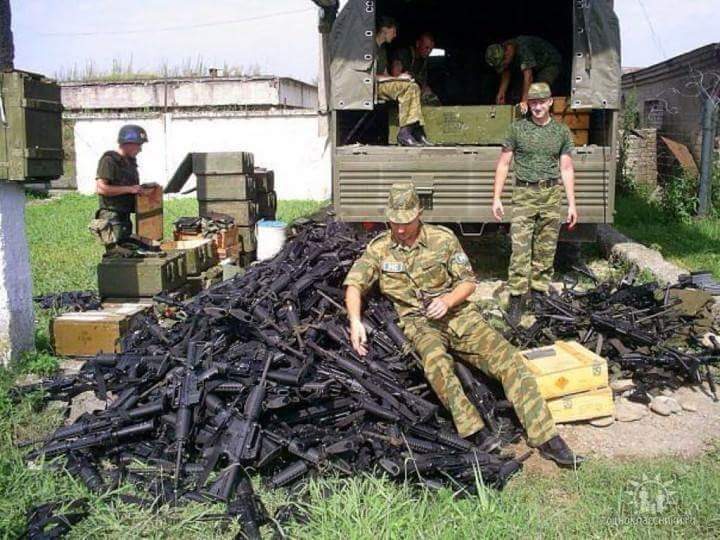
Meanwhile, in South Ossetia, Russian civil servants give Russian passport to any locals with Russian ancestry or links to Russia, which is pretty much the majority of people living in the region.
Diplomatic relations between Tbilisi and Moscow are tense and uneasy at best. Mikheil Saakashvili announces that he wants to reimpose Georgian control over South Ossetia, peacefully or forcefully. The two countries constantly argue and are tangled in commercial disputes and accusation of espionage and violation of airspace.
In July 2008, 4 Russian planes openly violate Georgian airspace. Georgia calls it an act of war, Moscow calls it a warning, saying its actions were aimed at preventing a Georgian military operation in South Ossetia.
Meanwhile, units of the Russian 58th Army based at Vladikavkaz in North Ossetia, conduct military drills dubbed Kavkaz 2008. It involves 8,000 troops, 700 vehicles and 30 planes. This includes units usually based in Chechnya. Those units do not withdraw back to base at the end of the drills, but instead remain in the field.
On the 1st of August 2008, South Ossetian separatists detonate a roadside bomb that wounds several Georgian police officers. The hostilities escalate rapidly as Georgian police forces, then army unit converge toward South Ossetia.
On the 5th of August, Yuri Popov, a senior Russian diplomat was quoted by Interfax as saying “If events develop according to the worst-case violence scenario, Russia will not allow itself to remain indifferent, considering that Russian citizens live in South Ossetia, particularly in the conflict zone.”
On the 6th of August, during the afternoon, Georgian and South Ossetians exchange artillery fire. The intensity goes crescendo throughout the day but at 19.00, Saakashvili announces a unilateral cease fire… Despite this, artillery fire is still being exchanged by both sides and on the 7th of August, out of the blue, a high ranking Georgian officer declares that Georgia is about to re-establish constitutional order in South Ossetia by force.
During the night of the 7th to the 8th of August, The Georgian artillery is getting more intense and indiscriminate: Shells are falling on civilian infrastructure as well as on the compound sheltering Russian peacekeepers.
On the 8th in the morning, the Georgian army moves in and attacks Tskhinvali, the South Ossetian capital.
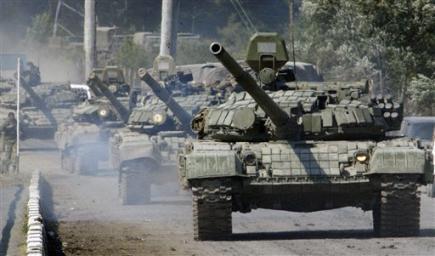
Battle Timeline
Day 1: 8th of August
The Georgian assault is overwhelming and only encounters South Ossetian militias and volunteers. By the morning of the 8th of August, Tskhinvali is almost totally surrounded and the Georgians control about 2/3 of the province. At the same time, Russian troops start streaming through the Roki tunnel, the only access from North Ossetia to South Ossetia. Alongside regular Russian troops are North Ossetian volunteers and Cossacks.
By 6am, Abkhaz and Russian troops in Abkhazia start moving toward the Georgian border.
The Russian air force starts targeting Georgian positions in South Ossetia, first, then starts targeting Georgia proper. The Georgian air force is mobilised. By 11am, Saakashvili announces that Georgia is mobilising its reserves as it is facing military aggression.
By 16.00, Russian armour is seen advancing toward Tskhinvali and the Russian air force is targeting the Vaziani military base situated in Tbilisi. The Marneuli airbase in Tbilisi is hit later on that evening.
By 20.19, Russian tanks enter the outskirts of Tskhinvali. The combats are violent, soldiers from both sides initially fight for each streets, each corner. That evening, the Russian column links up with the Russian peacekeepers’ compound. Russian and South Ossetian troops start slowly rolling back the Georgian forces.
At around 21.00, the Georgian port of Poti is in turn targeted by a heavy raid from the Russian air force.
Day 2: 9th of August
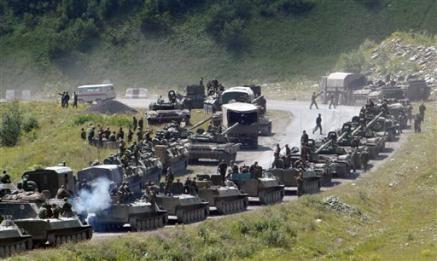
Georgian troops have been pushed out of Tskhinvali. Georgian army bases in Senaki, Gori and Tbilisi (Vaziani) are targeted as well as the train station of Senaki. Georgian civil servants and ministers are told to evacuate the ministry building for their own safety.
So far, Russia has lost two planes: A Tu-22 and a Su-25.
By the evening, no less than 5 Georgian cities are under fire from the Russian Air Force. Martial Law is declared in Georgia.
Day 3: 10th of August
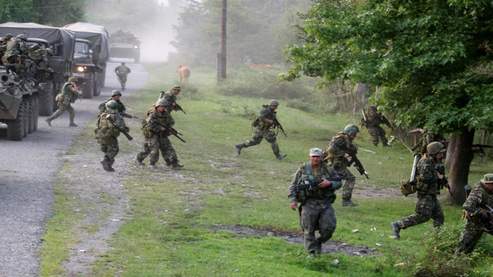
Russian Black Sea Fleet bring reinforcements to Abkhazia through the Abkhaz port of Ochamchire. At the same time, other Russian vessels start imposing a naval blocus off the Georgian port of Poti.
There are no Georgian troops left in South Ossetia.
Georgian patrol boats attack the Russian ships imposing a blocus. A small battle develop in which a Georgian vessel is sunk.
40 Russian cargo planes bring in troops to Sukhumi, the Abkhaz capital. They link up with the troops that had been landed by the navy earlier on that day. 9,000 Russian troops and 350 armoured vehicles are now in Abkhazia.
Day 4: 11th of August
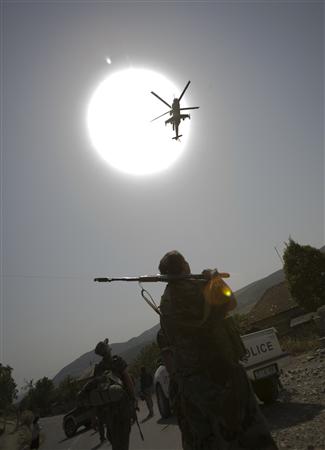
800 Georgian soldiers and their gears are flown from Iraq to Georgia by US cargo planes.
Russian troops are reported to have crossed the border between South Ossetia and Georgia. Civilians in the Georgian town of Gori are told to expect a Russian invasion. Georgian troops pull out of the town and form a defensive line in the town of Mtskheta, South of Gori.
Russian troops in Abkhazia bypass the Kodori Gorge (occupied by Georgian troops) and spill into Georgia proper. Georgian troops now fight a war on two fronts. Within hour, Russian troops capture the town of Zugdidi and the army base of Senaki.
The Russian Air Force loses another two Su-25.
Russian reconnaissance units arrive within reach of the Georgian port city of Poti.
Day 5: 12th of August
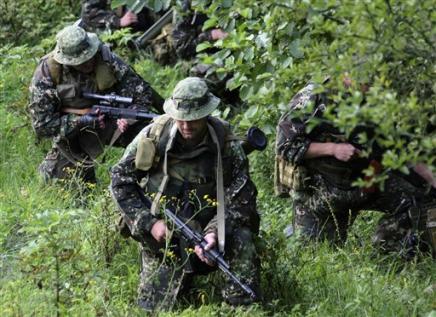
Russian troops seize the port of Poti.
Abkhaz forces with Russian support defeat the remnant of the Georgian forces in Abkhazia, in the Kodori Gorge.
The next day, Russian troops (a supported tank battalion) suddenly move forward and takes over Gori. They are a mere 60km from Tbilisi, the Georgian capital.
International Community Reaction and the Verdict
So, for the first time since the collapse of the Soviet Union, Russia had invaded a sovereign country. Let’s get the politics out of the way and see what was the reaction of the international community during and after the conflict!
It is fair to say that said international community was stunned by Russia’s military move into Georgia. From day one, frantic diplomatic activity gripped Western Chancelleries.
On the first day of the conflict, (August 8, 2008), The United States, Great Britain and NATO all call for a cease fire and an end of military hostilities by both Russia and Georgia. The next day (9th), US diplomats fly to Tbilisi to try and extinguish the conflict.
By August the 12th, Russia announces a halt to its military incursion into Georgia and agrees to follow a six point plan brokered by French president Nicolas Sarkozy. The following day, US secretary of State Condoleezza Rice starts working on a diplomatic mission that will take her to Paris and Tbilisi while the US announce the start of a humanitarian mission to Georgia.
On August the 15th, Mikheil Saakashvili signs the French sponsored cease fire agreement. Dimitry Medvedev signs said agreement the following day on behalf of Russia.
By the 16th of August, Russia seems to comply with the plan by withdrawing most of its forces from Georgia (in fact, some Russian troops will hold onto the port of Poti until September). But less than a week later, Moscow stuns the international community by suddenly announcing that its government formally recognises the independence of South Ossetia and Abkhazia. Medvedev signs the declaration into Russian law despite world wide protests.
The report commissioned by the European Union
Immediately after the war, the EU commissions an independent report. The findings are published in September 2009.
The report points the finger toward Saakashvili, saying that his mismanagement of the dispute opposing Georgia and its two breakaway regions created the perfect conditions for a conflict and opened the door to Moscow’s meddling in the region.
The report goes on saying that the (Georgian) shelling of Tskhinvali on the night of August the 7th was the spark that ignited the conflict between Russia and Georgia. As such, Tbilisi bears the responsibility for starting the war. The report also says that Georgia’s actions (the shelling of the South Ossetian capital) breaches international law.
However, the report also stipulates that while Moscow’s initial military reaction could be justified; the fact Moscow responded to the crisis with overwhelming forces and went on to push deep into Georgia proper “went far beyond the reasonable limits of defence” and was “in violation of international law”. Basically, while Moscow was right to send troops into South Ossetia to defend Russian peace keepers that were caught in the cross fire between South Ossetian and Georgian forces, it should have stopped there. As such, Moscow’s military response went beyond reasonable limits and violated international law as soon as Russian troops pushed beyond South Ossetia and into Georgia.
The report concludes that all sides that had taken part in this conflict (Georgian, Russian and South Ossetian forces) violated international law and human rights law.
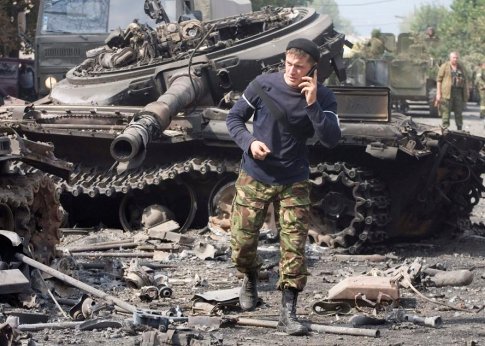
Battle analysis
The forces at play
When Georgia entered the war, it did so with an army of 15,000 men in active duty. To this, one can add 5,000 military police officers and 10,000 reservists mobilised once the Russians entered the war. That’s a total of 30,000 men under arms, but only half of those were professional soldiers.
The Armed Forces of South Ossetia were made up of 1,000 militiamen while the Abkhaz Armed Forces numbered 3,000 men.
At the beginning of the conflict, there were 250 Russian peacekeepers in Tskhinvali, South Ossetia and 2,500 peacekeepers in Abkhazia.
However, Russia rapidly deployed troops and up to 70,000 Russian soldiers ended up being involved in the Georgian campaign. Those Russian soldiers were supported by 300 combat aircraft and 1,200 armoured vehicles (including self propelled artillery), to which one might add 12 ships belonging to the Black Sea Fleet.
Russian units deployed against Georgia are identified are as follow:
– 4th Air and Air Defence Forces Army (HQ’d at Rostov-on-Don).
– 19th Motorized Rifle Division, 58th Army, based in Vladikavkaz (North Ossetia).
– 70th and 71st Motorized Rifle Regiments as well as GRU Spetnaz battalions Vostok and Zapad of the 42nd Guard Motorized Rifle Division, 58th Army, based in Khankala (Chechnya).
– Elements of the 104th and 234th Airborne Regiments of the 76th Air Assault Division from Pskov.
– GRU Spetnaz troops belonging to the 45th Intelligence Regiment, based in Kubinka/Moscow.
– Special Forces (Spetnaz): Men belonging to the 10th SF Brigades from Mol’kino and elements of the 22nd Special Forces Brigades from Stepnol.
– Units from the 7th Airborne Division from Novorossiysk
– 20th Motorized Rifle Division based in Volgograd
– Two battalions of Naval Infantry from the Black Sea Fleet
– 98th Guards Airborne division based in Ivanovo
Preparation, strategy and tactics of the Russian army in Georgia
There is no doubt that the Russian General Staff had planned ahead for a possible all out conflict between Georgia and Russia. If this campaign proved something, it is that the Russian high command still excels at strategic and contingency planning. Once the Russian army intervened in Georgia, it was immediately clear that Russian troops followed a carefully crafted and well resourced plan.
Moscow had indeed taken the odds of a conflict with Georgia seriously and had prepared accordingly. Several months before the conflict erupted, The Russian peacekeeping force in Abkhazia had received heavy armour not really compatible with a peace keeping mission. Furthermore, in May 2008, several hundred unarmed Russian troops were sent to Abhkazia to repair and upgrade railway roads. When the conflict erupted, Russian troops landed in Abkhazia by the Black Sea Fleet simply had to be mated to pre-positioned armour and transit by train, fast, toward the frontline…
As we will see below, the Georgian troops, at tactical levels, actually performed better than their Russian counterparts. However, the quality of the Russian planning at strategic level enabled Russian troops to overcome their shortcomings at tactical level. This level of planning and preparation gave Russia a decisive advantage over Georgia. The plan was such that victory did not depend at all on the tactical skills of the Russian troops involved on the ground. It depended instead on the ability of those Russian troops to stick to a simple plan and a simple timetable.
The operation bore the hallmarks of Soviet Deep Battle/Combined Arms doctrines. First and foremost, the overwhelming numbers of troops involved, in order to create local numerical superiority. Infantry advancing with the support of armour, artillery and air support also bore the Soviet Combined Arms trademark.
At the tactical level, Russian troops stuck to rigid Soviet tactics: Most of the time, they advanced in Column Formation. Upon contact with the enemy, those troops did not manoeuvre toward the flanks of the Georgian troops, instead, fighting from the lead elements of the column and pressing forward, pushing through contact.
Those tactics seem rigid, but they are better suited to lesser trained troops and conscripts. Those simple tactics also enabled the Russian formations to remain cohesive: In the absence of IFF systems, GPS-GLONASS navigation systems and adequate radios, more complex tactics or manoeuvres would have increased the risk of seeing Russian troops involved in friendly fire accident or compromise the tempo of advance.
In classic Soviet style, the advance toward Georgia and subsequently, in Georgia proper, was multi-pronged, aggressive and offensive minded. The Russian plan allowed for multiple fronts and multiple thrusts in various directions. This is also typically Soviet and enables the attacker to hold onto the initiative and dictate the tempo of battle, keeping the opponent unbalanced..
By refusing to deploy upon contact, the Russian forces accepted and received higher casualties. At the same time, it means the momentum of the advance was preserved. For the Georgian troops, it felt like fighting a steamroller. The relentless advance combined with air and artillery support seem to have had a shock effect on Georgian units.
The Black Sea Fleet provided fire support to Abkhaz and Russian forces advancing through the Kodori gorges in Abhkazia.
The swift deployment of close to 19,000 men in the first couple of days was key to success (10,000 through South Ossetia and 9000 through Abkhazia). 70,000 Russian troops ended up being involved in the conflict. That’s 70,000 men deployed inside of 5 days.
In Georgia, Moscow not only led a military battle against the Georgian army, it also waged a psychological and economic war against Tbilisi. Important economic nodes were systematically threatened, targetted, damaged, blockaded or seized.
As such, the naval embargo on Georgian ports and aerial bombing of Georgia’s airports and train stations not only hampered the deployment of reservists and prevented/dissuaded the arrival of possible foreign troops/support, it also placed the Georgian economy in a stranglehold.
By seizing the port of Poti, which is Georgia’s biggest port, Moscow put a stop to many major import and export operations vital for the country. Equally, when Russian forces pushed deep into Georgia, taking control of the main East-West highway, it not only cut the country in two and gained control of the country tactically and militarily speaking, but it also stopped the flow of people, service and goods at the same time.
Those moves were also meant to have a great psychological impact on the Georgian leadership. From Poti, the Russian forces were an hour away from Samtredia, a major Georgian city. From there, the Russians could have moved against the Baku-Tbilisi-Supsa pipeline as well as the ports of Supsa and Batumi, completely blockading the country’s ports and suffocating its economy.
By stopping just short of the capital city, Moscow put pressure on its enemy. Throughout the campaign, the Russians moved in such a way that it was always clear to the civilian and military authorities of Georgia that the situation could always become worse, that Moscow always had options to escalade the conflict at will. It was clear the initiative was firmly on the Russian side.
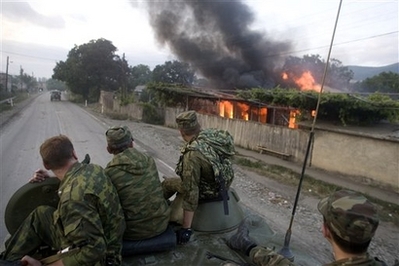
The good and the bad
Let’s start with the good!
– Fast mobilisation, great planning and good logistical skills:
As described above, logistically, the planning of the Russian campaign was good. Moving troops to Georgia was not a simple feat as South Ossetia and Georgia are situated behind the Greater Caucasus mountain range and only accessible by the Roki Tunnel and Abhkazia. The Roki tunnel could have easily been blocked and Abhkazia is roughly 400 nautical miles from the Russian base of Sevastopol. In those conditions, moving 40,000 men onto the theatre of operations and involving 70,000 men in total, inside of 5 days, was impressive indeed.
The Russian Navy ships arrived in Abkhazia on the second day of the war, meaning the 12 vessels involved must have departed from their base within hours of the beginning of the hostilities. Those ships not only unloaded 4,000 paratroopers in Abkhazia alongside tons of supplies, but they also enforced a naval blockade of Georgia’s ports and provided naval gun fire support to Abhkaz and Russian troops involved in fighting in and around the Kodiri gorges.
The RuAF contributed to around 300 combat aircraft (200 sorties) while Russian transport aircraft flew more than 100 sorties to move men, equipment, and supplies to the theatre of operations before and during the war.
– Exploiting Georgian mistakes:
When Georgian troops moved north of Tskinvhali, they met advanced Russian troops in sufficient numbers that they had to call in reserves. The reserve troops Georgia used were based in Senaki. By moving those troops to South Ossetia early during the war, Georgia basically left its Western Flank open. When the Russian troops landed in Abkhazia and spilled through into Georgia proper, there was not much left in the form of military opposition in that region.
– Using military operations to force a political decision:
As Carl von Clausewitz said, war is the continuation of politics (policy) by other means. The Russian army did not seize control of the Baku-Tbilisi-Ceyhan or the Baku-Supsa pipelines, but rather, placed forces close enough to their locations to threaten them. The Russian advance toward Tbilisi stopped 45 km from the Georgian capital. It was close enough to create panic, not just in Georgia, but in most European capitals. The move toward the capital and the pipelines put pressure on the Georgian leadership and European chancelleries.
The tempo was dictated by Moscow and it was clear the Russian armed forces still had options and could escalate the conflict further at very short notice. Moscow was in charge militarily and diplomatically.
By cutting the Tbilisi-Poti motorway, the Russian army not only cut off the Georgian capital from the Black Sea, it also cut the country in half and threatened to wreck its economy.
By involving paratroopers from all over Russia, Moscow managed to assemble large forces rapidly without having to go through mobilisation of reservists. In that case, it means that there was no large mobilisation signature prior to the operation.
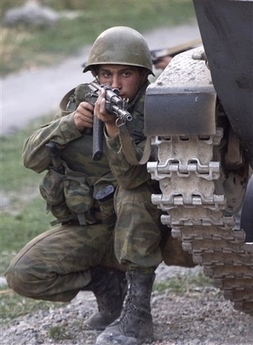
The bad. Hold on tight, there is a lot to discuss, here!
– Civilian leadership unprepared.
While the military had prepared for a war in Georgia, the Russian civilian authorities did not seem to have done so, or at least, did not expect a conflict in that region to erupt so soon. To say that the Russian civilian leadership was taken by surprise by the beginning of hostilities in Georgia would be an understatement!
It seems that by the time president Dmitry Medvedev agreed to military operations in Georgia, said operations had already started. He also agreed to the use of military force outside of the Russian Federation without consulting the Russian parliament. This, despite the fact that the Russian parliament is in theory the executive body that has the power to decide and authorise such an act.
As for his prime minister Vladimir Putin, he was in Beijing attending the Olympics when the hostilities broke out!
Russian troops had already entered into South Ossetia and the Russian Air Force was already operating over Georgia when the Russian Security Council finally convened!
– C4ISR (Command, Control, Communications, Computers, Intelligence, Surveillance and Reconnaissance)
Lack of reconnaissance (manned and unmanned). Russian troops emerging from the Roki tunnel encountered casualties on their way to the South Ossetian capital. They had no idea of what they were facing exactly. The lack of intelligence on the whereabouts of the enemy and its order of battle was almost complete. The lack of reconnaissance basically means the Russian troops went in blind, relying on blunt force.
Indeed, when the command group of the 58th Army tried to enter Tskhinvali, the vehicle column was ambushed and almost completely destroyed, killing and wounding many officers, including the commander, General Anatoly Khruliev, who suffered bullet wounds. The complete lack of situational awareness due to the lack of intelligence and reconnaissance was in this case blatant and caused unnecessary losses
The deficiencies in that area also caused difficulties for Russian troops and artillery to successfully locate and engage Georgian artillery units. Finally, the Russian air force also suffered during that short campaign, losing 10 aircraft (5 on the first day of the war) in 5 days (200 sorties).
While the lack of pilot training and the age and bad state of repairs of those platforms were all contributing factors, it is clear the lack of proper intelligence on the location of Georgian SAM batteries also came into play.
Communication was poor at all levels. Communications between the high command and troops on the ground, communication between the different units involved, communication between the different branches and communications between / amongst soldiers. All failed in one way or another.
One of the many example is that of the General Staff apparently being unable to contact the Minister of Defence by telephone for more than 10 hours after the start of the hostilities !
The 58th army had problems in keeping in touch with and contacting its own troops on the grounds. It also had trouble contacting its hierarchy in Moscow. A commander at 58th army headquarter is said to have borrowed a journalist’s satellite phone as his own radios did not work properly…
Individual soldiers did not carry radio sets. Communication had to be done within ear shot, visually or by using their own individual mobile phones.
The cooperation between land units and air force was especially bad. The two branches used different radio sets that were incompatible with one another. This led to troops on the grounds not to be able to communicate with friendly air assets flying directly overhead. It also meant that to request air support, ground troops first had to get in touch with their own headquarter. There, the ground commander would get in touch with his air force counterpart via mobile phone. The air force commander would then, in turn, relay the information to his own forces. This meant delay and an increased risk of collateral damage/friendly fire owing to the fluid and fast moving situation on the ground.
The presence of forward air controllers embedded with ground troop would have helped remedy the situation somewhat, but those were lacking also.
– Obsolete hardware:
The 58th Army, like any other units of the Russian armed forces, relied on old, obsolete and unreliable vehicles and platforms. The army’s T-62 and T-72 Main Battle Tanks were not only prone to break down but lacked IFF systems and night vision systems, leading to several cases of friendly fire. The majority of those tanks also went into battle without their ERA tiles or with said ERA cannisters still empty! This means that several Russian tanks fell victims of simple anti tank devices when they should have withstood such attacks had they been adequately prepared for battle.
It is estimated that by 2008, some 80 percent of Russian weaponry had not been refurbished or modernised since the collapse of the Soviet Union(in 1991). And it is a good bet to assume a lack of adequate care and maintenance for those platforms throughout the 1990’s decade. As a result, breakdown rate for all units involved in the 5 days conflict went as high as 50% of all vehicles involved… This not only hampered movement, but battle efficiency as well.
Russian soldiers lacked everything a modern warfighter should have. They lacked individual radios, night vision equipment and even body armour.
The Russian air force fielded planes that lacked all weather capabilities. The most numerous smart weapons available in the Russian armoury were of the TV guided or laser guided types. They were useless during operations in Georgia as the weather was overcast for most of the campaign. Furthermore, the plane’s electronic suites were hopelessly obsolete. Despite a numerical advantage and despite having more experienced pilots, the RuAF failed to establish full air superiority over Georgia.
The GLONASS constellation was still incomplete in 2008 and as the GPS signal was disrupted over Georgia during the campaign, the lack of GLONASS/GPS hurt both the navigation aspect as well as the accurate targeting of weaponry.
– Low readiness levels and bad leadership:
Both finding their roots in the outdated Soviet concept of cadre units: “Empty” units manned only by officers during peacetime. This system, leftover of the Soviet era, enabled the Red Army to rapidly expand in case of general mobilisation: Conscripts, reservists or drafted civilians would join the ranks of said unit which would then be deemed ready, with the experienced officers leading the green privates. The problem encountered in 2008 was that those career officers were of very poor quality indeed. It seems that better colonels and generals were handpicked throughout Russia to be flown in a hurry to units participating in the Georgian War to partially remedy this problem. As for the Russian soldiers, 70% of those who took part in this conflict were professional soldiers under contract (kontraktniky). This still leaves 30% of poorly trained conscripts deployed into an active warzone… Which in theory is in breach of the Russian law!
Units manned by professional soldiers were used and performed well. But while those units performed better than the units manned by conscripted personnel, they still lacked modern equipment.
The Georgian perspective
At the tactical level, Georgian troops seem to have behaved and performed better than their Russian counterparts. The individual Georgian soldier was better equipped and better trained. Indeed, those Georgian troops benefited from training supplied by the US ahead of their planned deployment in Iraq.
Their equipment was also better. They had better body armour, for once. Georgian MBT and Infantry Fighting Vehicles were equipped with ERA, night vision optics, modern radios and Israeli Fire Control Systems.
Georgian Su-25 had also been upgraded by the Israelis and as a result, were equipped with better communication, avionics and fire control systems than their Russian equivalent. This made the Georgian Frogfoot more survivable and all-weather capable.
However, Georgian troops suffered from a massive numerical inferiority. As a result of the Russian onslaught, their morale flagged rapidly. They indeed seem to have abandoned a lot of hardware when they retreated, in a panic, toward their capital city.
It seems the Georgian operation in South Ossetia was improvised and spontaneously planned very shortly before being launched. There was none of the meticulous planning demonstrated by the Russian staff, here. Georgian officers later complained about constant political interference during the war, with the civilian leadership of the country trying to micro manage every aspect of the operations throughout the 5 days of the conflict.
That’s new!
– Communication and propaganda
From day one, Russia launched itself into a frenetic communication campaign on all media platforms as well as into an intense diplomatic ballet on all fronts, from home to the Western chancelleries and the UN.
Russia justified its actions by Georgia’s “aggression” and perpetration of “genocide” in South Ossetia. Moscow, for the first time, claimed its right to protect Russian minorities situated beyond its borders and used this claim to justify its intervention in Georgia. Russia exaggerated the amplitude of the Georgian operation, talking about South Ossetian genocide. This confused Western Chancelleries long enough for Moscow to gain time and gain the upper hand in Georgia, putting the international community in front of a fait accompli.
The protection of Russian minorities that found themselves in new foreign countries after the fall of the Soviet Union has since been a regular theme in Russian diplomacy.
The topic was used again in 2014 after the pro-Western coup in Ukraine. It was also evoked by Vladimir Putin in 2016 who said “Russia’s border doesn’t end anywhere”. A clear statement that Moscow reserves the right to intervene on behalf of Russian minorities wherever they are.
A slight variation of this theme has also been used by Russian journalists and diplomats alike regarding the Russian operations in Syria. There, the Russian intervention has been painted by some as not in defence of Russian citizens but to protect the Orthodox minorities… In this case, the explanation was partly validated by the tacit support Moscow received from the Vatican itself!
In any case, during that August 2008 campaign, Moscow opted for the “louder is better” approach. Pro-Russian explanations, rhetoric and propaganda spread like wildfire on blogs, websites, “alternative and independent news sources” and newspapers around the world. The louder Moscow was, the more accusations were levelled against Georgia and the less Tbilisi could be heard… The Georgian case was not helped by its president, looking more and more dishevelled, incoherent and out of control with each of his apparitions on Georgian national television.
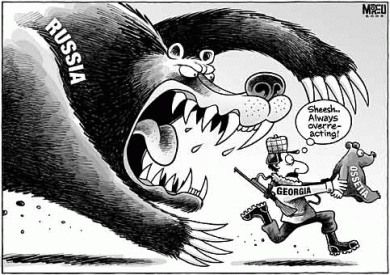
The Russian point of view and narrative was pushed forward to an international audience, camera crews embedded with Russian soldiers were reporting from the front, Western style… They showed villages in South Ossetia under Russian control and Russian civilians welcoming Russian troops as liberators. It was the first time Moscow, usually secretive with its military campaigns, played the openness card. Russian news outlet such as RT and Sputnik were at the forefront of that effort. Such information campaign and demonstrations of (controlled) transparency would be repeated in Crimea and Syria several years later.
– Cyber attacks
For the first time, Cyber attacks were also part of a Russian battle plan from the beginning: Russian entities launched cyber attacks on Georgian infrastructure, web nodes and servers throughout the conflict. The move did not yield decisive results and were more a nuisance than a threat to Georgia, but in hindsight, it was a taste of things to come.
– Buffer zones
The use of a frozen conflict or territorial dispute to prevent a country from becoming a NATO member state. It was used in Georgia in 2008 for the first time and the same recipe was used in Crimea and the Donbass region in 2014.
– Cossacks!
The involvement of Cossacks. The Kremlin has encouraged the resurgence of the Cossacks since the fall of the Soviet Union… Cossacks evoke Russian folklore and military prowess but also morality, loyalty and fortitude. Those semi-military communities were once the guardians of Imperial Russia’s Southern borders. In the past decade, these men have been used to support police forces in various Russian cities, most notably during the Sochi 2014 winter Olympics and 2018 football world cup. In 2008, in Georgia, Cossacks were deployed alongside the Russian army for the first time since WWI. They were to be seen again, in the Donbass from 2014 onward.
It was also, notably, the first time the Russians tried to operate its forces (Navy, interior Ministry, Air Force, Army) under a unified command.
Aftermath
During the five-day conflict, Georgia’s armed forces claimed to have suffered 184 dead and 1747 wounded. The civilian losses were estimated to less than 230. The Russian forces claimed to have incurred 67 dead and 283 wounded. It is generally accepted that both sides have downplayed those figures. A EU report states 850 dead civilians, just over 40% of those being South Ossetians. 100,000 civilians were forced to evacuate their home.
Georgia lost 32% of its MBT fleet (the majority of which were abandoned and subsequently captured), 5 ships, 3 planes and 4 helicopters. A fair amount of its artillery and IFVs was also damaged, captured or destroyed. The Israeli FCS and optics as well as American radios were flown back to Russia for close inspection. Most of the captured hardware was gifted to the South Ossetian and Abhkaz forces. In total, it is estimated that £400 millions worth of Georgian hardware was lost. For comparison, the entire annual Georgian defence budget is situated at around $360 millions.
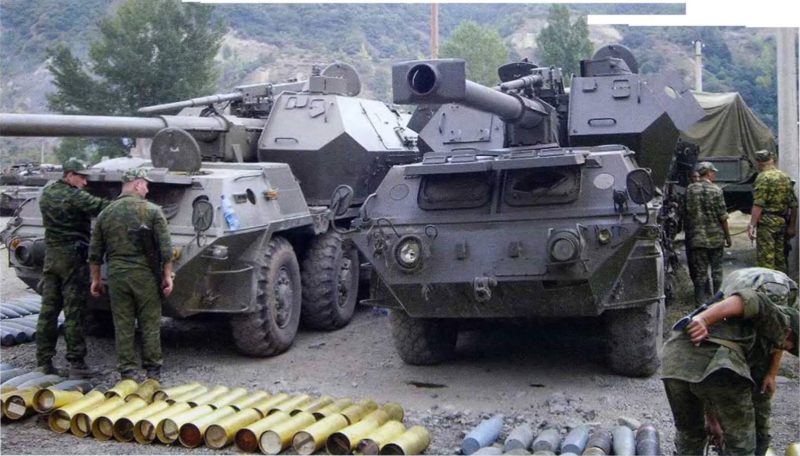
Russian Military goals
An operation is only successful as far as it has well defined objectives and that said objectives are fulfilled. In this instance, Moscow had several objectives.
– It certainly was a message, a red line in the sand, to indicate that trying to meddle within the Russian sphere of influence would not be without any consequences. It was also a signal from Moscow to both its neighbours and NATO that it would not tolerate any further North Atlantic Alliance expansion along Russian borders.
– To force NATO to reconsider offering membership to Georgia or at least to stop the process: South Ossetia and Abkhazia are used by Moscow as buffer zones. Indeed, Georgia cannot join NATO as long as it has a territorial dispute or is involved in a military conflict. Tbilisi has two choices: Give up on its dreams of NATO membership or give up its territorial claim over the two lost provinces. A third choice would be to retake control of those provinces by force but that option seems unrealistic.
– By taking irreversible control of Abkhazia and South Ossetia, Moscow demonstrated not only a lack of willingness (or inability) from NATO to come to the help of potential new members. It certainly exposed NATO’s political divisions. It also demonstrated to its neighbours that considering NATO membership is one thing, but actively pursuing said membership would have consequences.
– To humiliate or at least humble the Georgian leadership and demonstrate to Georgia that its economy and safety largely depended on Moscow’s good will. That is also a message addressed to Moscow’s other neighbours.
– To destroy most of the Georgian armed forces on land or at sea as well as to destroy and / or capture a maximum of Georgian army hardware / infrastructure. Soviet operational art aims to annihilate an opponent’s armed forces In this case, Moscow brought war to the Georgian capital less than 24 hours after the beginning of the conflict (Through its air force). Within 5 days, Georgia had been cut in 2 and had lost control over two of its provinces. Furthermore, Tbilisi had lost its air force and navy as well as 150 large pieces of equipment captured by the Russians.
– Some see the Russo-Georgian war of 2008 as Moscow’s revenge for over a decade of European and NATO expansion Eastward. They also see it as a revenge for having recognised Kosovo as a sovereign and independent state in 2008. While revenge cannot be seen as the primary or even secondary goal of the Russian military operation in Georgia, you can be sure that those events were in the back of the minds of the Russian military planners.
Military Legacy
Militarily speaking, Russia is now in a much better posture in the South Caucasus and Black sea region than it was prior to 2008. By gaining control of Abkhazia and South Ossetia, The Russian armed forces have bypassed the main bottlenecks in the region: The Roki tunnel and the Caucasus mountains. From Abkhazia and South Ossetia, Moscow is in a position to dominate and influence the area and can use those bases as springboards for further military operations should it be needed.
Moscow has gained a large naval base in the Black Sea, with Ochamchire being currently upgraded for use by the Black Sea Fleet. It has also gained a large airbase with the former Soviet Airbase of Gudauta (Abkhazia) being manned by Russian personnel once again.
Political and diplomatic legacy
On the 14th of August 2008, Georgia’s parliament voted to withdraw from the Commonwealth of Independent States. Shortly after, on August the 26th, Russia formally recognised South Ossetia and Abkhazia as independent states. 10 years later, in January 2018, the South Ossetian Armed forces were officially merged into the Russian army.
Regardless of the realities on the terrain, this conflict changed the dynamics in the post Soviet space. Perception is everything, and Moscow appeared determined in protecting its interests and defending its allies (even if it means resorting to the use of force) in what it perceives as its sphere of influence. All the while, NATO and the EU looked indecisive, unwilling and divided. As such, Armenia, Belarus and Kyrgyzstan, already traditional allies of Russia, went on to strengthen their diplomatic, economic and military ties with Moscow in the years following the 2008 war.
Even the West backed down, for a while. Who can forget Secretary of State Clinton presenting Lavrov with a symbolic Reset button in March 2009, a mere 7 months after the end of the conflict in Georgia!
Military reforms
Following its campaign in Georgia, Moscow was actually very self-critical. The war had been won despite glaring deficiencies plaguing the Russian armed forces.
A series of reforms and State Armament Plans have been rolled out since 2008. Every single one of them could warrant a full article, so we won’t dwell on those too much, but we shall nevertheless look at the big picture.
Most of those reforms and plans aimed to make the Russian armed forces leaner, better equipped and better trained. The first step was to slim down the bloated officer corps, while at the same time work on a viable and workable Western style Non Commissioned Officer corps. The army size was to be drawn down to 1 million men, too. The professionalisation of the Russian armed forces was also a priority, with a sharp increase in recruitment of contract soldiers. To make a military career more attractive to the masses and increase retention levels, wages were raised and improvements were made to barracks, army bases and soldier’s living conditions in general.
The Russian armed forces also focussed on switching from the heavy Divisionnal organisation inherited from the soviet era to a more flexible Battalion Tactical Groups style organisation, Western Style. They, however, kept and reorganised division sized units on the Western Military District, facing NATO.
The Russian State Program 2011-2020 focussed on modernising the army’s equipment and supplying Russian troops with decent hardware and kits.
The amount of money dedicated to the 2020 Russian Armament program was $312 billions. 70% of which was to be dedicated to new hardware and weapon platforms, 15% to the repair and modernisation of existing platforms and 15% invested to Research and development.
The 2020 plan main goal was to see the share of modern hardware represent 70% of the total equipment operated by the Russian armed forces. Progress were made for MBTs, IFVs, APCs, fighter jets and long range strategic bombers as well as in submarines and to a lesser extend, surface vessels. Progress were also made in the procurement and use of UAVs, EW platforms and long range artillery (including tactical and strategic missile platforms). Finally, the individual soldier was finally handed over a modern kit in the form of the Ratnik infantry combat system. The Ratnik combines body armour, communication systems and various other items going from the humble flashlight to various day and night optics.
The 2020 program had a positive impact on the state and capabilities of Russian armed forces, but it is not to say it was smooth sailing and that all its objectives were reached. The Western Military District was the main beneficiary of this spending spree. And while the Southern and Northern Districts also saw an influx of new and modernised hardware, it seems the Eastern Military District is still currently operating legacy Soviet platforms.
The Russian involvement in Crimea and in the Ukrainian crisis in 2014 brought in Western economic sanctions to which was added the pain of low oil and gas prices. The inability to procure some key components for its armed forces (modern optics, gas turbines and so on) forced Moscow to adapt its plan.
The 2020 plan was replaced by a 2018–2017 State Armament Plan. While it carries on the work of its predecessor, this plan is also less ambitious. It takes into account the delays incurred due to Western sanctions (the time it takes for the Russian industry to source new foreign suppliers or gear up to manufacture products of substitutions to replace Western sources ones). It also downsizes or delays prestigious and ambitious but costly programs such as the Su-57 jet, the Armata program (T-14, T-15, Kurganets, Bumerang and Koalitsiya), the Lider Class Destroyer, Project 23000E Shtorm carrier and the Lavina Landing Ship.
Nevertheless, those programs have had a positive effects on the Russian Armed forces and their capabilities. The Russian army of today is much better prepared for a conflict than it was a decade ago. Furthermore, Moscow has proven to be flexible, learning lessons from its operations in Ukraine and Syria fast and modifying or adapting the state program according to findings and lesson learned on the ground. Russia has also seized the opportunity to rotate a large amount of its troops through those two theatres of operations (3 to 4 months tour) so that a maximum of soldiers benefit from hands-on experience. A majority of Russian pilots and army officers were also rotated in and out of Syria.
[/MM_Access_Decision]











“Immediately after its independence, Georgia faces two insurrections from provinces loyal to Moscow: South Ossetia and Abkhazia. ”
This is an completely incorrect statement.
Abkhazia functioned as an independent state since 1992. But in the beginning of their history, Abkhazia wasn’t loyal to Moscow. In September 1993, Georgian president Shevardnadze went to Abkhazia. But as a result of the actions of the Abkhaz armed forces, the President of Georgia was blocked at the Sukhumi airfield. And Shevartnadze was rescued by Russian army. Here is the complete story in russian independent newspaper – https://translate.google.ru/translate?sl=ru&tl=en&u=http%3A%2F%2Fwww.ng.ru%2Fcis%2F2000-01-25%2F5_savers.html